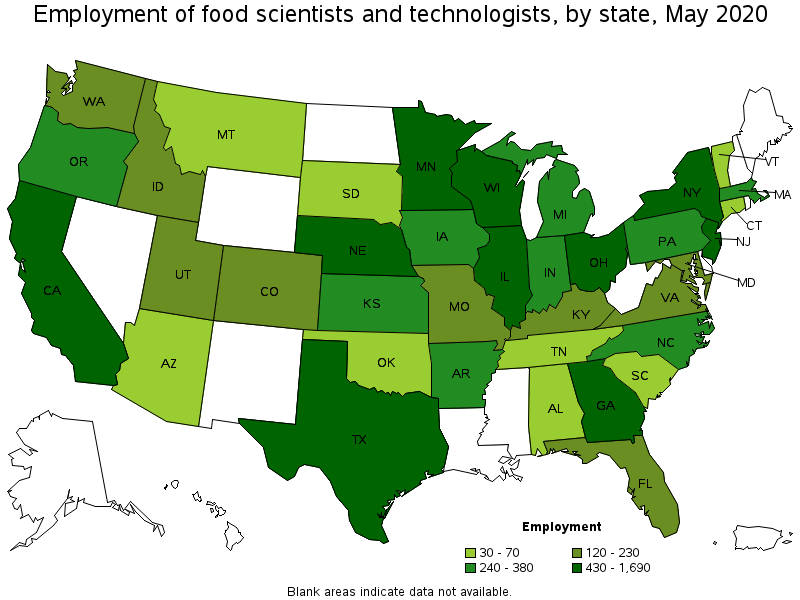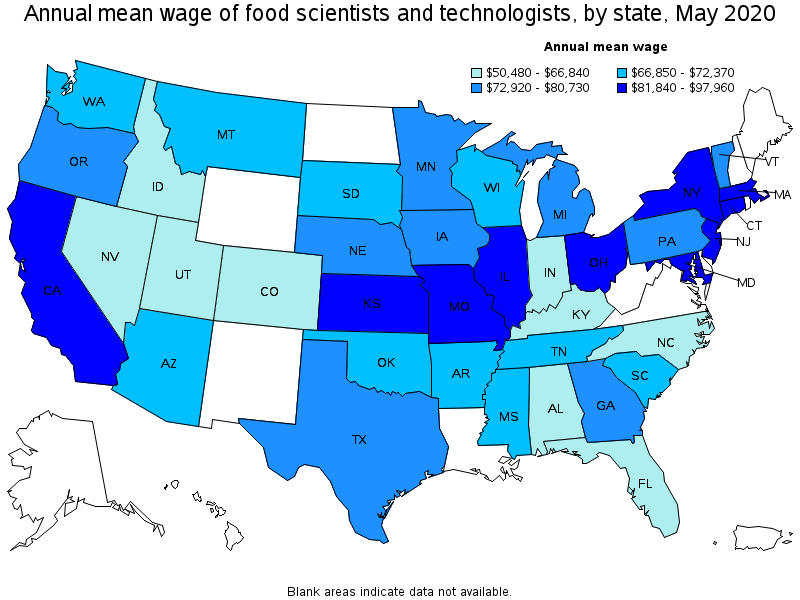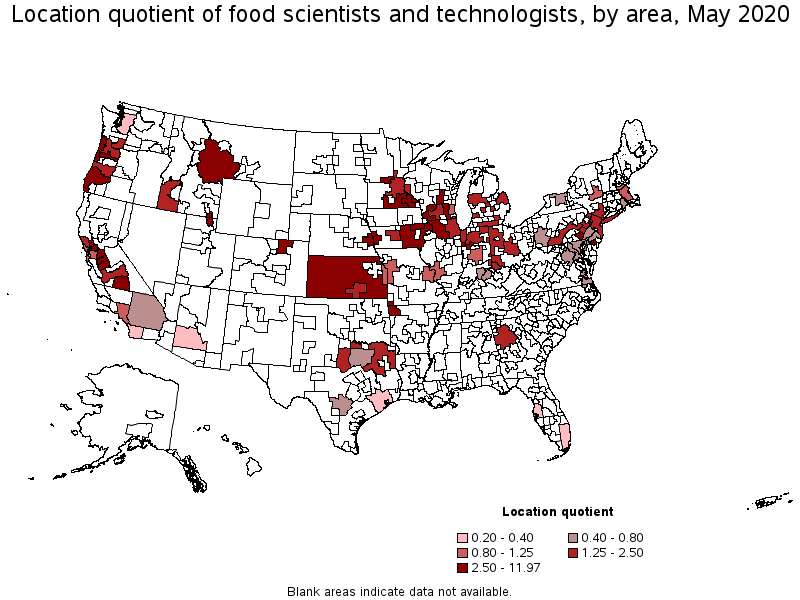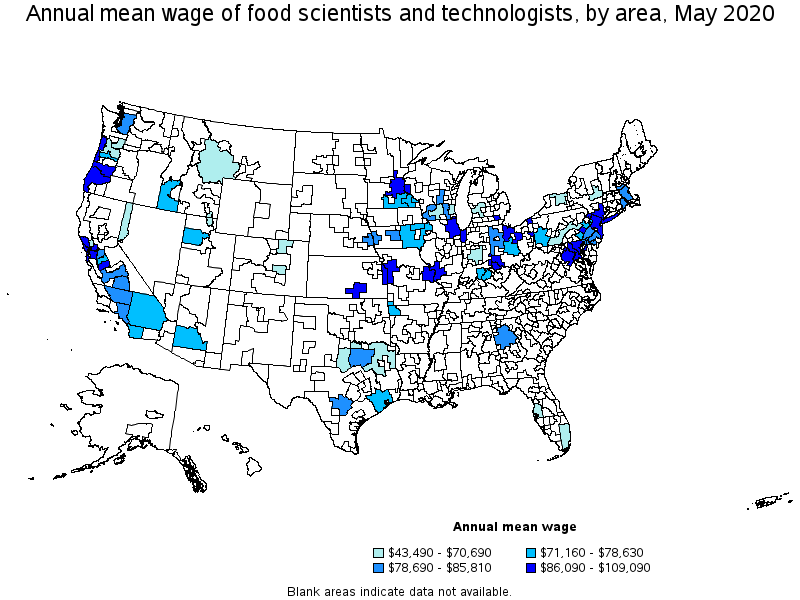An official website of the United States government
 United States Department of Labor
United States Department of Labor
Use chemistry, microbiology, engineering, and other sciences to study the principles underlying the processing and deterioration of foods; analyze food content to determine levels of vitamins, fat, sugar, and protein; discover new food sources; research ways to make processed foods safe, palatable, and healthful; and apply food science knowledge to determine best ways to process, package, preserve, store, and distribute food.
Employment estimate and mean wage estimates for Food Scientists and Technologists:
| Employment (1) | Employment RSE (3) |
Mean hourly wage |
Mean annual wage (2) |
Wage RSE (3) |
|---|---|---|---|---|
| 13,080 | 3.9 % | $ 38.55 | $ 80,190 | 1.4 % |
Percentile wage estimates for Food Scientists and Technologists:
| Percentile | 10% | 25% | 50% (Median) |
75% | 90% |
|---|---|---|---|---|---|
| Hourly Wage | $ 19.83 | $ 26.11 | $ 35.31 | $ 48.02 | $ 62.71 |
| Annual Wage (2) | $ 41,240 | $ 54,300 | $ 73,450 | $ 99,870 | $ 130,430 |
Industries with the highest published employment and wages for Food Scientists and Technologists are provided. For a list of all industries with employment in Food Scientists and Technologists, see the Create Customized Tables function.
Industries with the highest levels of employment in Food Scientists and Technologists:
| Industry | Employment (1) | Percent of industry employment | Hourly mean wage | Annual mean wage (2) |
|---|---|---|---|---|
| Other Food Manufacturing | 2,330 | 1.02 | $ 41.18 | $ 85,650 |
| Management of Companies and Enterprises | 1,610 | 0.07 | $ 45.59 | $ 94,820 |
| Dairy Product Manufacturing | 1,310 | 0.87 | $ 34.64 | $ 72,050 |
| Grain and Oilseed Milling | 900 | 1.46 | $ 43.51 | $ 90,500 |
| Scientific Research and Development Services | 890 | 0.12 | $ 42.41 | $ 88,220 |
Industries with the highest concentration of employment in Food Scientists and Technologists:
| Industry | Employment (1) | Percent of industry employment | Hourly mean wage | Annual mean wage (2) |
|---|---|---|---|---|
| Grain and Oilseed Milling | 900 | 1.46 | $ 43.51 | $ 90,500 |
| Other Food Manufacturing | 2,330 | 1.02 | $ 41.18 | $ 85,650 |
| Dairy Product Manufacturing | 1,310 | 0.87 | $ 34.64 | $ 72,050 |
| Animal Food Manufacturing | 330 | 0.51 | $ 35.41 | $ 73,660 |
| Fruit and Vegetable Preserving and Specialty Food Manufacturing | 760 | 0.46 | $ 36.76 | $ 76,450 |
Top paying industries for Food Scientists and Technologists:
| Industry | Employment (1) | Percent of industry employment | Hourly mean wage | Annual mean wage (2) |
|---|---|---|---|---|
| Federal Executive Branch (OEWS Designation) | 80 | (7) | $ 51.71 | $ 107,560 |
| Management of Companies and Enterprises | 1,610 | 0.07 | $ 45.59 | $ 94,820 |
| Wholesale Electronic Markets and Agents and Brokers | 50 | 0.01 | $ 44.47 | $ 92,490 |
| Grain and Oilseed Milling | 900 | 1.46 | $ 43.51 | $ 90,500 |
| Scientific Research and Development Services | 890 | 0.12 | $ 42.41 | $ 88,220 |
States and areas with the highest published employment, location quotients, and wages for Food Scientists and Technologists are provided. For a list of all areas with employment in Food Scientists and Technologists, see the Create Customized Tables function.

States with the highest employment level in Food Scientists and Technologists:
| State | Employment (1) | Employment per thousand jobs | Location quotient (9) | Hourly mean wage | Annual mean wage (2) |
|---|---|---|---|---|---|
| California | 1,690 | 0.10 | 1.09 | $ 40.75 | $ 84,750 |
| New Jersey | 1,240 | 0.33 | 3.50 | $ 40.53 | $ 84,300 |
| Illinois | 1,000 | 0.18 | 1.89 | $ 45.35 | $ 94,330 |
| Ohio | 770 | 0.15 | 1.60 | $ 47.09 | $ 97,960 |
| Minnesota | 640 | 0.24 | 2.53 | $ 38.38 | $ 79,830 |

States with the highest concentration of jobs and location quotients in Food Scientists and Technologists:
| State | Employment (1) | Employment per thousand jobs | Location quotient (9) | Hourly mean wage | Annual mean wage (2) |
|---|---|---|---|---|---|
| Nebraska | 490 | 0.52 | 5.50 | $ 37.80 | $ 78,630 |
| New Jersey | 1,240 | 0.33 | 3.50 | $ 40.53 | $ 84,300 |
| Arkansas | 340 | 0.29 | 3.07 | $ 33.70 | $ 70,110 |
| Kansas | 320 | 0.24 | 2.54 | $ 44.89 | $ 93,370 |
| Minnesota | 640 | 0.24 | 2.53 | $ 38.38 | $ 79,830 |

Top paying states for Food Scientists and Technologists:
| State | Employment (1) | Employment per thousand jobs | Location quotient (9) | Hourly mean wage | Annual mean wage (2) |
|---|---|---|---|---|---|
| Ohio | 770 | 0.15 | 1.60 | $ 47.09 | $ 97,960 |
| Connecticut | 40 | 0.02 | 0.25 | $ 46.57 | $ 96,880 |
| Illinois | 1,000 | 0.18 | 1.89 | $ 45.35 | $ 94,330 |
| Kansas | 320 | 0.24 | 2.54 | $ 44.89 | $ 93,370 |
| Maryland | 230 | 0.09 | 0.96 | $ 44.45 | $ 92,470 |

Metropolitan areas with the highest employment level in Food Scientists and Technologists:
| Metropolitan area | Employment (1) | Employment per thousand jobs | Location quotient (9) | Hourly mean wage | Annual mean wage (2) |
|---|---|---|---|---|---|
| New York-Newark-Jersey City, NY-NJ-PA | 1,250 | 0.14 | 1.50 | $ 41.79 | $ 86,930 |
| Chicago-Naperville-Elgin, IL-IN-WI | 850 | 0.20 | 2.08 | $ 45.81 | $ 95,290 |
| Los Angeles-Long Beach-Anaheim, CA | 500 | 0.09 | 0.91 | $ 40.11 | $ 83,420 |
| Minneapolis-St. Paul-Bloomington, MN-WI | 360 | 0.19 | 2.07 | $ 42.38 | $ 88,160 |
| Omaha-Council Bluffs, NE-IA | 350 | 0.75 | 7.97 | $ 40.36 | $ 83,940 |
| Atlanta-Sandy Springs-Roswell, GA | 350 | 0.13 | 1.41 | $ 38.30 | $ 79,650 |
| Fayetteville-Springdale-Rogers, AR-MO | 280 | 1.13 | 11.97 | $ 34.85 | $ 72,490 |
| San Francisco-Oakland-Hayward, CA | 260 | 0.11 | 1.17 | $ 48.65 | $ 101,180 |
| Dallas-Fort Worth-Arlington, TX | 240 | 0.07 | 0.72 | $ 38.52 | $ 80,130 |
| Cincinnati, OH-KY-IN | 200 | 0.19 | 2.07 | $ 41.39 | $ 86,090 |

Metropolitan areas with the highest concentration of jobs and location quotients in Food Scientists and Technologists:
| Metropolitan area | Employment (1) | Employment per thousand jobs | Location quotient (9) | Hourly mean wage | Annual mean wage (2) |
|---|---|---|---|---|---|
| Fayetteville-Springdale-Rogers, AR-MO | 280 | 1.13 | 11.97 | $ 34.85 | $ 72,490 |
| Vineland-Bridgeton, NJ | 60 | 1.10 | 11.74 | $ 37.90 | $ 78,830 |
| Napa, CA | 60 | 0.87 | 9.26 | $ 32.83 | $ 68,280 |
| Merced, CA | 50 | 0.75 | 7.97 | $ 44.28 | $ 92,100 |
| Omaha-Council Bluffs, NE-IA | 350 | 0.75 | 7.97 | $ 40.36 | $ 83,940 |
| Lafayette-West Lafayette, IN | 60 | 0.69 | 7.29 | (8) | (8) |
| Visalia-Porterville, CA | 90 | 0.62 | 6.58 | $ 39.94 | $ 83,080 |
| Logan, UT-ID | 30 | 0.56 | 5.99 | $ 22.48 | $ 46,760 |
| Modesto, CA | 90 | 0.50 | 5.31 | $ 34.65 | $ 72,070 |
| St. Cloud, MN | 40 | 0.38 | 3.99 | (8) | (8) |

Top paying metropolitan areas for Food Scientists and Technologists:
| Metropolitan area | Employment (1) | Employment per thousand jobs | Location quotient (9) | Hourly mean wage | Annual mean wage (2) |
|---|---|---|---|---|---|
| Wichita, KS | 60 | 0.20 | 2.09 | $ 51.01 | $ 106,090 |
| San Francisco-Oakland-Hayward, CA | 260 | 0.11 | 1.17 | $ 48.65 | $ 101,180 |
| Washington-Arlington-Alexandria, DC-VA-MD-WV | 160 | 0.05 | 0.56 | $ 47.17 | $ 98,110 |
| St. Louis, MO-IL | 110 | 0.08 | 0.88 | $ 46.99 | $ 97,730 |
| Santa Rosa, CA | 40 | 0.21 | 2.22 | $ 46.64 | $ 97,000 |
| Baltimore-Columbia-Towson, MD | 90 | 0.07 | 0.75 | $ 46.17 | $ 96,040 |
| Kansas City, MO-KS | 80 | 0.08 | 0.81 | $ 45.96 | $ 95,590 |
| Chicago-Naperville-Elgin, IL-IN-WI | 850 | 0.20 | 2.08 | $ 45.81 | $ 95,290 |
| Merced, CA | 50 | 0.75 | 7.97 | $ 44.28 | $ 92,100 |
| Vallejo-Fairfield, CA | 30 | 0.25 | 2.62 | $ 43.62 | $ 90,730 |
Nonmetropolitan areas with the highest employment in Food Scientists and Technologists:
| Nonmetropolitan area | Employment (1) | Employment per thousand jobs | Location quotient (9) | Hourly mean wage | Annual mean wage (2) |
|---|---|---|---|---|---|
| Southeast Minnesota nonmetropolitan area | 160 | 1.10 | 11.70 | $ 35.72 | $ 74,300 |
| South Central Wisconsin nonmetropolitan area | 110 | 0.59 | 6.24 | $ 39.99 | $ 83,180 |
| Kansas nonmetropolitan area | 110 | 0.30 | 3.20 | (8) | (8) |
| Southeast Iowa nonmetropolitan area | 90 | 0.41 | 4.41 | $ 35.39 | $ 73,610 |
| Balance of Lower Peninsula of Michigan nonmetropolitan area | 60 | 0.23 | 2.49 | (8) | (8) |
Nonmetropolitan areas with the highest concentration of jobs and location quotients in Food Scientists and Technologists:
| Nonmetropolitan area | Employment (1) | Employment per thousand jobs | Location quotient (9) | Hourly mean wage | Annual mean wage (2) |
|---|---|---|---|---|---|
| Southeast Minnesota nonmetropolitan area | 160 | 1.10 | 11.70 | $ 35.72 | $ 74,300 |
| South Central Wisconsin nonmetropolitan area | 110 | 0.59 | 6.24 | $ 39.99 | $ 83,180 |
| Southeast Iowa nonmetropolitan area | 90 | 0.41 | 4.41 | $ 35.39 | $ 73,610 |
| Northwest Illinois nonmetropolitan area | 50 | 0.40 | 4.29 | (8) | (8) |
| Coast Oregon nonmetropolitan area | 40 | 0.35 | 3.77 | $ 42.37 | $ 88,120 |
Top paying nonmetropolitan areas for Food Scientists and Technologists:
| Nonmetropolitan area | Employment (1) | Employment per thousand jobs | Location quotient (9) | Hourly mean wage | Annual mean wage (2) |
|---|---|---|---|---|---|
| North Northeastern Ohio nonmetropolitan area (noncontiguous) | (8) | (8) | (8) | $ 52.45 | $ 109,090 |
| Coast Oregon nonmetropolitan area | 40 | 0.35 | 3.77 | $ 42.37 | $ 88,120 |
| West Northwestern Ohio nonmetropolitan area | 30 | 0.14 | 1.51 | $ 40.30 | $ 83,830 |
| South Central Wisconsin nonmetropolitan area | 110 | 0.59 | 6.24 | $ 39.99 | $ 83,180 |
| Southeast Minnesota nonmetropolitan area | 160 | 1.10 | 11.70 | $ 35.72 | $ 74,300 |
These estimates are calculated with data collected from employers in all industry sectors, all metropolitan and nonmetropolitan areas, and all states and the District of Columbia. The top employment and wage figures are provided above. The complete list is available in the downloadable XLS files.
The percentile wage estimate is the value of a wage below which a certain percent of workers fall. The median wage is the 50th percentile wage estimate—50 percent of workers earn less than the median and 50 percent of workers earn more than the median. More about percentile wages.
(1) Estimates for detailed occupations do not sum to the totals because the totals include occupations not shown separately. Estimates do not include self-employed workers.
(2) Annual wages have been calculated by multiplying the hourly mean wage by a "year-round, full-time" hours figure of 2,080 hours; for those occupations where there is not an hourly wage published, the annual wage has been directly calculated from the reported survey data.
(3) The relative standard error (RSE) is a measure of the reliability of a survey statistic. The smaller the relative standard error, the more precise the estimate.
(7) The value is less than .005 percent of industry employment.
(8) Estimate not released.
(9) The location quotient is the ratio of the area concentration of occupational employment to the national average concentration. A location quotient greater than one indicates the occupation has a higher share of employment than average, and a location quotient less than one indicates the occupation is less prevalent in the area than average.
Other OEWS estimates and related information:
May 2020 National Occupational Employment and Wage Estimates
May 2020 State Occupational Employment and Wage Estimates
May 2020 Metropolitan and Nonmetropolitan Area Occupational Employment and Wage Estimates
May 2020 National Industry-Specific Occupational Employment and Wage Estimates
Last Modified Date: March 31, 2021